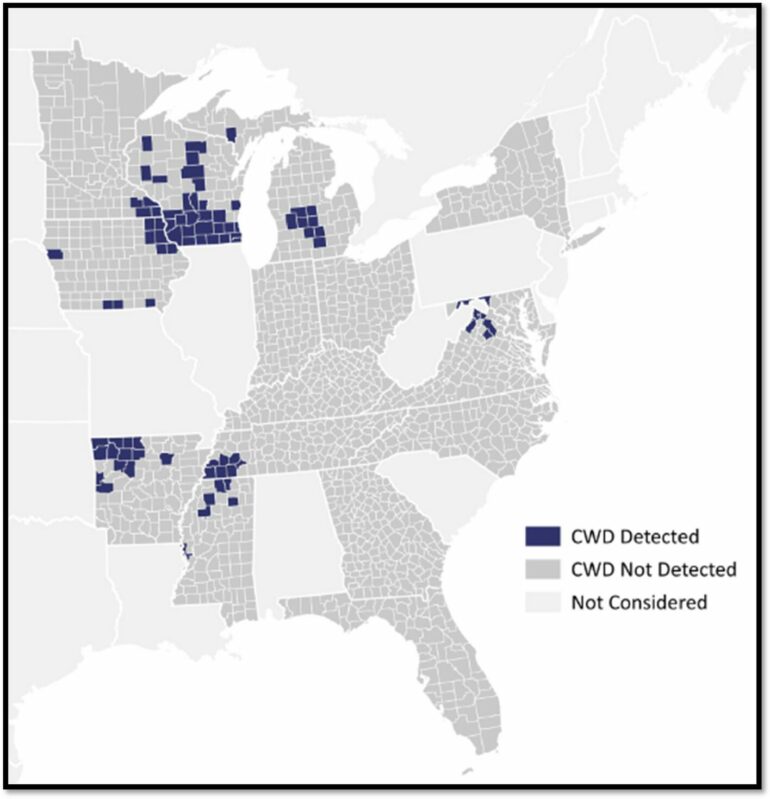Wildlife experts have developed a regional computer model—and user-friendly app—that predicts counties in 16 states where wildlife managers should target their surveillance of chronic wasting disease in deer, helping them conserve scarce money and labor resources.
The model—described in a paper published June 22 in Scientific Reports—highlights areas with similar conditions to counties known to harbor chronic wasting disease, so agencies can then focus their efforts.
The model was made possible by pooling chronic wasting disease and other data from wildlife agencies in 16 eastern and midwestern states. The collaboration breaks a cycle of agencies staying siloed within their states, which has made regional assessments difficult in spite of their importance, because deer don’t honor human boundaries.
“We’re not making a lot of progress on our own, so we need to do it more collectively,” said Krysten Schuler, assistant research professor in the Department of Public and Ecosystem Health and director of the Cornell Wildlife Health Lab in the College of Veterinary Medicine. “We can use these big data techniques by pooling our data resources that will help us move farther ahead faster, as chronic wasting disease has been found in 34 states.”
At the same time, a closer look at the data reveals that while the geographic spread appears wide, the disease has appeared in a relatively few number of counties across those states, Schuler said, “The scale at which you’re looking at this matters.”
So far, chronic wasting disease infects only animals in the deer family—white-tailed deer, mule deer, elk and moose—but scientists worry it might jump to other animals, including humans. Infected deer spread prions, misfolded proteins that persist in the environment, which are spread through urine, saliva and carcasses and can infect other deer when ingested.
The disease leads to neurological disorders, weight loss, abnormal behavior, lack of fear and death. It has been eradicated from New York state after appearing in 2005, but reintroduction from other affected states remains a constant threat, further underscoring the need for surveillance. If detected early, wildlife professionals can cull deer before the disease spreads.
In addition to the data of chronic wasting disease cases, developers also incorporated other information such as state regulations, human activities and risk factors, as people are known to move prions in live animals and carcasses, and landscape features such as streams where deer may congregate and spread disease, and soil. Prions are ionically charged and bind to certain soil types, including clay.
The team used existing algorithms and applied them to predicting chronic wasting disease for the first time. Using 2020 data, four different algorithms were tested to predict which counties might be positive for chronic wasting disease, and the results were then checked against 2021 data. Each algorithm emphasized different risk factors. The Light Boosting Gradient model was found to be the most reliable predictor, given the regional data.
“If we add more data in, we may have stronger conclusions about which risk factors are most important, because collecting data is one of the challenges in ecology,” Schuler said.
The Cornell Wildlife Health Lab’s Surveillance Optimization Project for Chronic Wasting Disease provides resources for wildlife professionals, including custom software for agencies to standardize and manage their chronic wasting disease data, a Chronic Wasting Disease Data Warehouse with other computer models, and disease data from other states.
Study co-authors include researchers from the University of California, Davis; Michigan State University; the U.S. Fish and Wildlife Service; the University of Tennessee; the Arkansas Game and Fish Commission; the Florida Fish and Wildlife Conservation Commission; departments of natural resources in Georgia, Iowa, Indiana, Maryland, Michigan, Minnesota, Ohio and Wisconsin; the Kentucky Department of Fish and Wildlife Resources; the Mississippi Department of Wildlife, Fisheries and Parks; the New York State Department of Environmental Conservation and the North Carolina Wildlife Resources Commission.
More information:
Md Sohel Ahmed et al, Predicting chronic wasting disease in white-tailed deer at the county scale using machine learning, Scientific Reports (2024). DOI: 10.1038/s41598-024-65002-7
Provided by
Cornell University
Citation:
Predicting chronic wasting disease in counties could prevent spread (2024, June 27)



